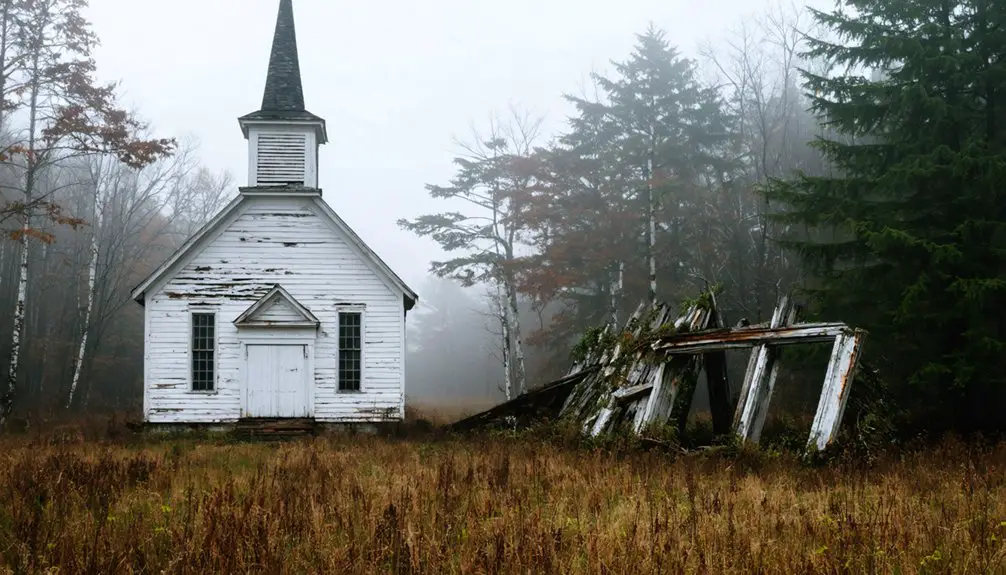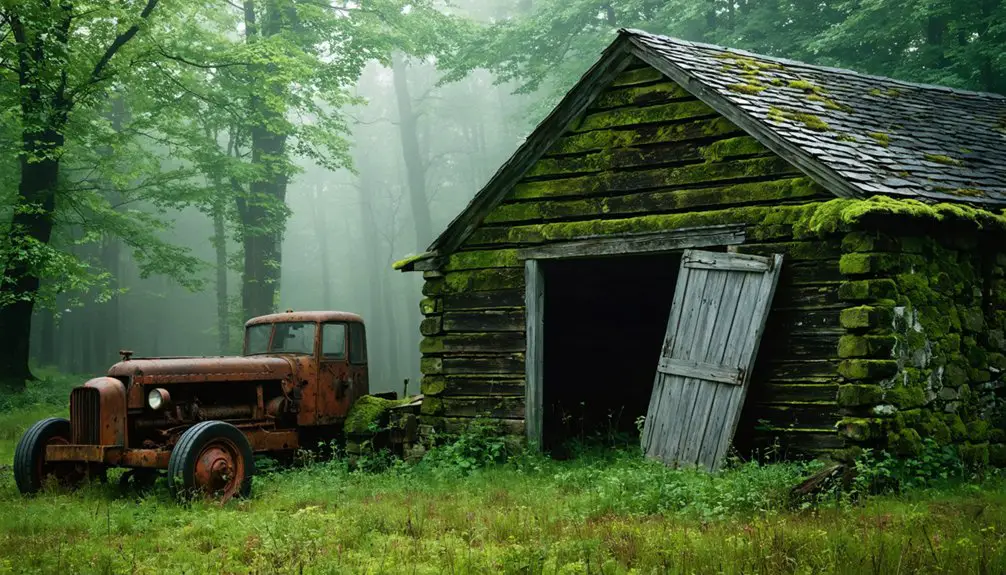You’ll find East Fletcher, Vermont, as a poignant example of New England’s lost communities. Chartered in 1781, this settlement thrived on timber, agriculture, and ice harvesting from Halfmoon Pond. The town’s original buildings, including an 1830 town hall, gradually succumbed to isolation and economic decline as residents sought opportunities elsewhere. Today, hidden foundations and remnants of industrial structures lie scattered throughout the reforested landscape, each holding untold stories of Vermont’s rural past.
Key Takeaways
- East Fletcher was a settlement in Vermont chartered in 1781 that declined due to geographic isolation and economic challenges.
- Agricultural hardship, poor soil conditions, and harsh winters forced many residents to abandon their farms in East Fletcher.
- Young residents migrated to urban areas for better opportunities, leading to population decline and eventual abandonment.
- Physical remnants include the 1830 town hall, scattered foundations, and industrial ruins now overtaken by forest growth.
- The area’s economic activities included timber processing, ice harvesting, and agricultural operations before its decline into a ghost town.
Origins and Early Settlement
While Vermont was still establishing itself following the Revolutionary War, the Vermont Legislature and Governor Thomas Chittenden chartered Fletcher, Vermont on August 20, 1781.
The legislature awarded land grants to influential Vermonters, including General Samuel Fletcher, a brigadier general known for his military achievements.
Settlement began in 1784, as early families ventured into the wilderness with minimal resources – typically just a horse and cow.
Armed with only basic livestock, brave settlers embarked into Vermont’s untamed wilderness to forge new lives in 1784.
You’ll find that these pioneers faced significant hardships, as evidenced by the tragic death of settler Fullington from bilious colic after consuming raw turnip.
Like many frontier settlements across Vermont, this area supported iron furnaces and mining operations in its early days.
His widow persevered, continuing the journey with her children and later giving birth to Fletcher’s first child, a daughter named Lamoille.
The settlement centered along the Lamoille River, where families cleared dense forest to establish their homesteads.
Subsequent settlers who contributed to the town’s early development included Lemuel Scott and Dea. Peter Thurston.
Industries That Shaped the Community
As East Fletcher emerged from its pioneer phase, diverse industries shaped the economic landscape of this Vermont settlement.
You’ll find that the timber industry dominated early development, with sawmills harnessing stream power to process the region’s abundant forests. Agricultural processing facilities, including starch factories and creameries, transformed local farm products into marketable goods. Like many New England communities that experienced industrial decline, East Fletcher’s businesses gradually faded as economic conditions shifted. One such business was a family-owned mechanic shop that operated from the 1920s using an honor system payment method.
- Ice harvesting operations at Halfmoon Pond yielded up to 27,000 blocks annually, providing crucial refrigeration before electrification.
- Traditional blacksmithing crafts supported transportation and farming needs through wheelwright workshops and metal forging.
- Sawmills served as economic anchors, processing timber for both local construction and regional markets.
- Small-scale retail establishments connected the dispersed population, with stores operating as significant community hubs.
These industries sustained East Fletcher’s independence until modern transportation and technology led to their decline.
Daily Life in East Fletcher
Life in East Fletcher revolved around the demanding rhythms of rural subsistence, where farming families structured their days according to seasonal patterns and agricultural necessities. You’d find yourself rising at dawn, heading to the fields with hand tools and draft animals to tend crops of corn, potatoes, and hay. The sweet scent of maple syrup production filled the spring air, as Sugar Hill pioneered Vermont’s signature industry.
Your children would balance their schooling in one-room schoolhouses with essential farm chores, while community gatherings strengthened social bonds through shared labor and celebration. Stories of missing townspeople from nearby Bennington Triangle served as cautionary tales for families venturing into the wilderness.
Through shared work and festive gatherings, rural families found harmony between education and farm duties, building lasting community bonds.
Agricultural practices dominated daily routines, from maple sugaring in spring to wood cutting in winter. You’d rely on horse-drawn wagons for transportation, participate in town meetings for civic engagement, and join your neighbors for barn raisings and harvest festivals.
The church served as both spiritual guide and social hub, weaving together the fabric of East Fletcher’s close-knit community.
The Path to Abandonment
Despite its promising beginnings as a chartered rural community in 1781, East Fletcher’s journey toward abandonment stemmed from a complex interplay of geographic isolation and economic challenges.
You’ll find the town’s demographic shifts were driven by several key factors that ultimately led to its demise:
- Agricultural decline intensified as poor soil conditions and harsh winters made farming increasingly unprofitable.
- Limited infrastructure development and lack of public services pushed residents toward better-equipped towns.
- Young populations migrated to urban centers for employment and educational opportunities.
- Natural reforestation gradually consumed abandoned farmlands and structures.
The transformation from thriving agricultural community to ghost town accelerated through the late 19th and early 20th centuries, as industrialization favored more accessible locations.
The town’s self-sufficient lifestyle had historically served as a protective factor during major disease outbreaks, but it couldn’t prevent the economic downturn that led to its abandonment.
Today, visitors can explore the remaining structures along the Slate History Trail, which provides glimpses into the town’s past.
Without economic diversification or sufficient transportation links, East Fletcher couldn’t sustain its population against the mounting pressures of modernization.
Remnants and Historical Legacy

Today’s visitors to East Fletcher encounter a landscape where history peeks through the overwhelming force of nature.
You’ll find the original town hall, now a private residence dating to 1830, standing as one of the few intact architectural influences from the settlement era. Throughout the dense forest, you can spot remnants of charcoal kilns and scattered foundations of homes and company buildings that once housed industrial workers. Evidence reveals the area relied on steam-powered operations for its iron production activities.
The area’s legacy lives on through its compelling folklore elements, including mysterious disappearances and unexplained phenomena that earned it a place in the “Bennington Triangle” narrative. One notable case involved Paula Weldon, a Bennington College student who mysteriously vanished in December 1946 and was never found.
While documented records are scarce, oral histories and family holdings provide glimpses into the community’s past. The ghost town’s transformation from a bustling industrial center to an isolated wilderness mirrors Vermont’s broader shift from resource extraction to forest reclamation.
Frequently Asked Questions
Are There Any Documented Paranormal Activities or Ghost Sightings in East Fletcher?
You won’t find documented ghostly encounters or spectral legends here – research shows no confirmed paranormal activity in this area, with Vermont’s supernatural stories concentrating instead around Glastenbury Mountain and other locations.
Can Visitors Legally Explore and Photograph the Remaining Structures Today?
Like an ancient social media post without likes, you’ll need to verify visitation regulations and photography permissions locally, as no documented public access exists for these potentially private structures.
What Wildlife Dangers Should Hikers Be Aware of When Visiting?
You’ll need to watch for black bears and avoid sudden encounters by making noise. While snake bites are rare, stay alert for timber rattlesnakes. Moose can be especially dangerous during mating season.
Does East Fletcher Have Any Connection to the Bennington Triangle Mysteries?
You’ll find no substantiated link between East Fletcher and the Bennington Triangle mysteries, as the documented paranormal activities and disappearances are centered around Glastenbury Mountain, over 100 miles from East Fletcher’s location.
Are There Guided Tours or Annual Events Celebrating East Fletcher’s History?
You won’t find guided history tours or annual festivals celebrating this location, as research shows no documented evidence of organized tourism activities or commemorative events in historical records or local planning documents.
References
- https://www.youtube.com/watch?v=6zrC4j7tGHE
- http://sites.rootsweb.com/~vermont/FranklinFletcher.html
- https://passageport.org/journey/the-story-of-iron-in-crown-point-moriah/14-the-invisible-town-of-fletcherville/
- https://en.wikipedia.org/wiki/List_of_ghost_towns_in_Vermont
- https://outside.vermont.gov/agency/ACCD/bylaws/Bylaws and Plans Approved/Fletcher_Proposed_MunicipalPlan_January_2019.pdf
- http://freepages.rootsweb.com/~gtusa/history/usa/vt.htm
- https://obscurevermont.com/tag/forgotten/page/2/
- https://www.familysearch.org/en/wiki/Fletcher
- https://www.vtliving.com/towns/fletcher/
- https://outside.vermont.gov/agency/ACCD/bylaws/Bylaws and Plans Approved/Fletcher-MunicipalPlan_2005.pdf



